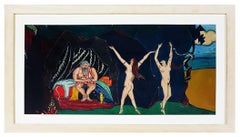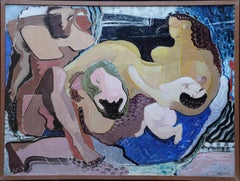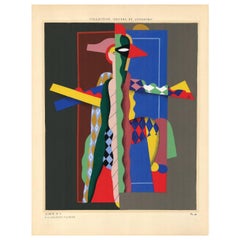Georges Valmier Art
to
1
Overall Width
to
Overall Height
to
1
1
1
1
1
1
1
1
1
1
1
9,445
2,689
1,375
1,359
1
1
Artist: Georges Valmier
The Temptation - Painting by Georges Valmier - Early 20th Century
By Georges Valmier
Located in Roma, IT
The Temptation is a modern artwork realized by Georges Valmier in the early 20th Century.
Mixed colored tempera painting.
Hand signed on the lower m...
Category
Early 20th Century Modern Georges Valmier Art
Materials
Paper, Tempera
Related Items
Myth III - British 1936 Modern art tempera painting Ida Graves poet family
By Blair Hughes-Stanton
Located in Hagley, England
This superb British 1930's modern art tempera painting is by noted interwar artist Blair Hughes-Stanton. Painted in 1936 it is part of the myth se...
Category
1930s Modern Georges Valmier Art
Materials
Egg Tempera
Blair Hughes-StantonMyth III - British 1936 Modern art tempera painting Ida Graves poet family, 1936
$19,392 Sale Price
20% Off
H 32 in W 40 in D 1 in
"Two Pueblo Dancers, Santa Clara" Pablita Velarde, New Mexico Native American
Located in New York, NY
Pablita Velarde
Two Pueblo Dancers, Santa Clara, 1993
Signed and dated lower right
Casein on paper
7 1/2 x 7 1/4 inches
Provenance
Adobe Gallery, New Mexico
Private Collection, Texa...
Category
1990s American Modern Georges Valmier Art
Materials
Paper, Casein
$5,500
H 15.75 in W 15.75 in
Defeated, Figurative, Tempera on Paper by Sanat Kar "In Stock"
By Sanat Kar
Located in Kolkata, West Bengal
Sanat Kar - Defeated
Tempera on Paper
17.5 x 13 inches, 2001
(Unframed & Delivered)
“Defeated” (2001) by Sanat Kar is a surreal tempera painting that portrays a haunting, mask-like ...
Category
Early 2000s Modern Georges Valmier Art
Materials
Paper, Tempera
$2,099
H 17.5 in W 13 in D 1 in
The Magician oil and tempera painting by Julio de Diego
By Julio de Diego
Located in Hudson, NY
Julio De Diego’s Atomic Series paintings made an extraordinary statement regarding the shock and fear that accompanied the dawn of the nuclear age. In the artist’s own words, “Scientists were working secretly to develop formidable powers taken from the mysterious depths of the earth - with the power to make the earth useless! Then, the EXPLOSION! . . . we entered the Atomic Age, and from there the neo-Atomic war begins. Explosions fell everywhere and man kept on fighting, discovering he could fight without flesh.”
To execute these works, De Diego developed a technique of using tempera underpainting before applying layer upon layer of pigmented oil glazes. The result is paintings with surfaces which were described as “bonelike” in quality. The forms seem to float freely, creating a three-dimensional visual effect. In the 1954 book The Modern Renaissance in American Art, author Ralph Pearson summarizes the series as “a fantastic interpretation of a weighty theme. Perhaps it is well to let fantasy and irony appear to lighten the devastating impact. By inverse action, they may in fact increase its weight.”
Exhibited
1964 Marion Koogler McNay Art Institute, San Antonio, Texas
This work retains its original frame which measures 54" x 42" x 2"
About this artist: Julio De Diego crafted a formidable persona within the artistic developments and political struggles of his time. The artist characterized his own work as “lyrical,” explaining, “through the years, the surrealists, the social-conscious painters and the others tried to adopt me, but I went my own way, good, bad or indifferent.” [1] His independence manifested early in life when de Diego left his parent’s home in Madrid, Spain, in adolescence following his father’s attempts to curtail his artistic aspirations. At the age of fifteen he held his first exhibition, set up within a gambling casino. He managed to acquire an apprenticeship in a studio producing scenery for Madrid’s operas, but moved from behind the curtains to the stage, trying his hand at acting and performing as an extra in the Ballet Russes’ Petrouchka with Nijinsky. He spent several years in the Spanish army, including a six-month stretch in the Rif War of 1920 in Northern Africa. His artistic career pushed ahead as he set off for Paris and became familiar with modernism’s forays into abstraction, surrealism, and cubism.
The artist arrived in the U.S. in 1924 and settled in Chicago two years later. He established himself with a commission for the decoration of two chapels in St. Gregory’s Church. He also worked in fashion illustration, designed magazine covers and developed a popular laundry bag for the Hotel Sherman. De Diego began exhibiting through the Art Institute of Chicago in 1929, and participated in the annual Chicago Artists Exhibitions, Annual American Exhibitions, and International Water Color Exhibitions. He held a solo exhibition at the Art Institute of Chicago in the summer of 1935. Though the artist’s career was advancing, his family life had deteriorated. In 1932 his first marriage dissolved, and the couple’s young daughter Kiriki was sent to live with friend Paul Hoffman.
De Diego continued to develop his artistic vocabulary with a growing interest in Mexican art. He traveled throughout the country acquainting himself with the works of muralists such as Carlos Merida, and also began a collection of small native artifacts...
Category
1940s American Modern Georges Valmier Art
Materials
Masonite, Oil, Tempera
Durga, Indian Goddess, Mythology, Tempera & Pastel on board in Brown "In Stock"
By Suhas Roy
Located in Kolkata, West Bengal
Suhas Roy - Durga - 20 x 20 inches (unframed size)
Tempera and Pastel on Board , 2005
( Framed & Door Delivered )
Durga- Indian goddess combating evil...
Category
Early 2000s Modern Georges Valmier Art
Materials
Pastel, Tempera, Board
$4,112
H 20 in W 20 in D 1 in
Inevitable Day – Birth of the Atom oil and tempera painting by Julio De Diego
By Julio de Diego
Located in Hudson, NY
Julio De Diego’s Atomic Series paintings made an extraordinary statement regarding the shock and fear that accompanied the dawn of the nuclear age. In the artist’s own words, “Scientists were working secretly to develop formidable powers taken from the mysterious depths of the earth - with the power to make the earth useless! Then, the EXPLOSION! . . . we entered the Atomic Age, and from there the neo-Atomic war begins. Explosions fell everywhere and man kept on fighting, discovering he could fight without flesh.”
To execute these works, De Diego developed a technique of using tempera underpainting before applying layer upon layer of pigmented oil glazes. The result is paintings with surfaces which were described as “bonelike” in quality. The forms seem to float freely, creating a three-dimensional visual effect. In the 1954 book The Modern Renaissance in American Art, author Ralph Pearson summarizes the series as “a fantastic interpretation of a weighty theme. Perhaps it is well to let fantasy and irony appear to lighten the devastating impact. By inverse action, they may in fact increase its weight.”
Bibliography
Art in America, April 1951, p.78
About this artists: Julio De Diego crafted a formidable persona within the artistic developments and political struggles of his time. The artist characterized his own work as “lyrical,” explaining, “through the years, the surrealists, the social-conscious painters and the others tried to adopt me, but I went my own way, good, bad or indifferent.” [1] His independence manifested early in life when de Diego left his parent’s home in Madrid, Spain, in adolescence following his father’s attempts to curtail his artistic aspirations. At the age of fifteen he held his first exhibition, set up within a gambling casino. He managed to acquire an apprenticeship in a studio producing scenery for Madrid’s operas, but moved from behind the curtains to the stage, trying his hand at acting and performing as an extra in the Ballet Russes’ Petrouchka with Nijinsky. He spent several years in the Spanish army, including a six-month stretch in the Rif War of 1920 in Northern Africa. His artistic career pushed ahead as he set off for Paris and became familiar with modernism’s forays into abstraction, surrealism, and cubism.
The artist arrived in the U.S. in 1924 and settled in Chicago two years later. He established himself with a commission for the decoration of two chapels in St. Gregory’s Church. He also worked in fashion illustration, designed magazine covers and developed a popular laundry bag for the Hotel Sherman. De Diego began exhibiting through the Art Institute of Chicago in 1929, and participated in the annual Chicago Artists Exhibitions, Annual American Exhibitions, and International Water Color Exhibitions. He held a solo exhibition at the Art Institute of Chicago in the summer of 1935. Though the artist’s career was advancing, his family life had deteriorated. In 1932 his first marriage dissolved, and the couple’s young daughter Kiriki was sent to live with friend Paul Hoffman.
De Diego continued to develop his artistic vocabulary with a growing interest in Mexican art. He traveled throughout the country acquainting himself with the works of muralists such as Carlos Merida, and also began a collection of small native artifacts...
Category
1940s American Modern Georges Valmier Art
Materials
Masonite, Oil, Tempera
Ceremonial Dancers oil and tempera painting by Julio De Diego
By Julio de Diego
Located in Hudson, NY
Artwork measures 48" x 30" and framed 56 ¼" x 38 ¼" x 3"
Provenance:
John Heller Gallery, NYC, circa 1975 (label verso)
The artist's daughter
Corbino Galleries, Sarasota, FL (1990)...
Category
1940s Modern Georges Valmier Art
Materials
Masonite, Oil, Tempera
$26,000
H 48 in W 30 in
St. Atomic oil and tempera painting by Julio de Diego
By Julio de Diego
Located in Hudson, NY
Julio De Diego’s Atomic Series paintings made an extraordinary statement regarding the shock and fear that accompanied the dawn of the nuclear age. In the artist’s own words, “Scientists were working secretly to develop formidable powers taken from the mysterious depths of the earth - with the power to make the earth useless! Then, the EXPLOSION! . . . we entered the Atomic Age, and from there the neo-Atomic war begins. Explosions fell everywhere and man kept on fighting, discovering he could fight without flesh.”
To execute these works, De Diego developed a technique of using tempera underpainting before applying layer upon layer of pigmented oil glazes. The result is paintings with surfaces which were described as “bonelike” in quality. The forms seem to float freely, creating a three-dimensional visual effect. In the 1954 book The Modern Renaissance in American Art, author Ralph Pearson summarizes the series as “a fantastic interpretation of a weighty theme. Perhaps it is well to let fantasy and irony appear to lighten the devastating impact. By inverse action, they may in fact increase its weight.”
Exhibited
1950 University of Illinois at Urbana "Contemporary American Painting"
1964 Marion Koogler McNay Art Institute, San Antonio, Texas
This work retains its original frame which measures 54" x 36" x 2".
About this artist: Julio De Diego crafted a formidable persona within the artistic developments and political struggles of his time. The artist characterized his own work as “lyrical,” explaining, “through the years, the surrealists, the social-conscious painters and the others tried to adopt me, but I went my own way, good, bad or indifferent.” [1] His independence manifested early in life when de Diego left his parent’s home in Madrid, Spain, in adolescence following his father’s attempts to curtail his artistic aspirations. At the age of fifteen he held his first exhibition, set up within a gambling casino. He managed to acquire an apprenticeship in a studio producing scenery for Madrid’s operas, but moved from behind the curtains to the stage, trying his hand at acting and performing as an extra in the Ballet Russes’ Petrouchka with Nijinsky. He spent several years in the Spanish army, including a six-month stretch in the Rif War of 1920 in Northern Africa. His artistic career pushed ahead as he set off for Paris and became familiar with modernism’s forays into abstraction, surrealism, and cubism.
The artist arrived in the U.S. in 1924 and settled in Chicago two years later. He established himself with a commission for the decoration of two chapels in St. Gregory’s Church. He also worked in fashion illustration, designed magazine covers and developed a popular laundry bag for the Hotel Sherman. De Diego began exhibiting through the Art Institute of Chicago in 1929, and participated in the annual Chicago Artists Exhibitions, Annual American Exhibitions, and International Water Color Exhibitions. He held a solo exhibition at the Art Institute of Chicago in the summer of 1935. Though the artist’s career was advancing, his family life had deteriorated. In 1932 his first marriage dissolved, and the couple’s young daughter Kiriki was sent to live with friend Paul Hoffman.
De Diego continued to develop his artistic vocabulary with a growing interest in Mexican art. He traveled throughout the country acquainting himself with the works of muralists such as Carlos Merida, and also began a collection of small native artifacts...
Category
1940s American Modern Georges Valmier Art
Materials
Masonite, Oil, Tempera
Ganesha, Tempera on Board by Lalu Prasad Shaw "In Stock"
By Lalu Prasad Shaw
Located in Kolkata, West Bengal
Lalu Prasad Shaw
Ganesha
Tempera on Board
26 x 20 Inches
2016
Style : Known widely for his highly stylized portraits of Bengali women and couples, Lalu Prasad Shaw’s works lay the...
Category
2010s Modern Georges Valmier Art
Materials
Mixed Media, Tempera, Board
$8,780
H 20 in W 20 in D 1 in
Abstract Expressionist Tempera on Paper Figurative -- The Pilot and His Plane
By Jean Kellogg
Located in Soquel, CA
Wonderful abstract expressionist figurative of a pilot and his plane attributed to Jean Kellogg (American, 1910 - 1995), circa 1970. Unsigned. (Purchased ...
Category
1970s Modern Georges Valmier Art
Materials
Paper, Tempera
$1,200 Sale Price
20% Off
H 28 in W 22.25 in D 0.25 in
Svejk And The Beer II - Figurative Painting Yellow Brown Green Blue Pink White
By Yovana Dimitrova
Located in Sofia, BG
"Svejk And The Beer II" is a figurative, romantic painting by Maestro Yovana Dimitrova,
She is an emerging artist.
About the artwork:
TECHNIQUE: Tempera painting
STYLE: Contemporary
Edition : Unique, signed
Weight: Approximately 3 kg.
“The impressions of Yovana's paintings on the viewer is perfection.
Her paintings bring emotion happiness, positive energy and make you think about the nowadays problems. This painting represent the vast creative power of her talent.”
Dear art lovers,
if you like the art of maestro Dimitrova, please click the link to follow this artist and art gallery Snow Pearl to discover all our artists and beautiful artworks.
Thank you so much! we appreciate your interest to our work.
Numerous artworks of the artist have been sold to galleries and individuals around the world
A certificate of authenticity of the artwork is delivered by Snow Pearl art gallery.
Category
2010s Modern Georges Valmier Art
Materials
Tempera, Panel
Yovana DimitrovaSvejk And The Beer II - Figurative Painting Yellow Brown Green Blue Pink White, 2018
$1,651
H 59.06 in W 35.44 in D 0.79 in
Untitled, Tempera on Board by Modern Indian Artist Lalu Prasad Shaw "In Stock"
By Lalu Prasad Shaw
Located in Kolkata, West Bengal
Lalu Prasad Shaw - Untitled - 25 x 20.5 inches
Tempera on Board, 2015
Style : Known widely for his highly stylized portraits of Bengali women and couples, Lalu Prasad Shaw’s works lay the most emphasis on his subject’s physical characteristics. Capturing the expressions of his subjects perfectly with the greatest economy of line and colour each of Shaw’s paintings has an intimate feel to it.
Influenced by the pre-independence Company School of art, the traditional Kalighat Pat and the Ajanta cave paintings, Shaw’s works, mainly executed in gouache or tempera, like his own person, are simple and graceful, having a very still, well-composed and smooth exterior. This senior artist draws his inspiration primarily from nature and the milieu surrounding the great Bengali middle class, often depicting pleasant and quiet scenes from his own life on his canvases and papers. His style is unique and modern in its adaptation of academic and traditional Indian formats.
A particularly notable aspect of Shaw's paintings is their simple yet sophisticated look. One notices a seamless synthesis of different stylistic elements to achieve a phenomenal effect.
About the Artist and his work :
Born : 1937 in Bengal.
Education : completed his education in fine arts at the Government College of Arts and Crafts in Kolkata.
International Shows :
1970 - Second British Biennale in London;
1974 - Norwegian Print...
Category
2010s Modern Georges Valmier Art
Materials
Tempera, Board
Lalu Prasad ShawUntitled, Tempera on Board by Modern Indian Artist Lalu Prasad Shaw "In Stock", 2015
$9,849
H 25 in W 20.5 in D 1 in
Previously Available Items
Collection Decors et Couleurs. Album No. 1. Pochoirs designed by George Valmier
By Georges Valmier
Located in New York, NY
VALMIER, Georges. Collection Decors et Couleurs. Album No. 1. Illustrated with 20 pochoir plates. Folio, issued loose in original tan portfolio, pochoir title on front board, with ties. Original tissue guards present. Paris: Aux Editions Albert Levy, 1930.
One of 100 copies. A perfect copy of this Art Deco port-folio of brightly coloured pochoir plates designed by the French painter Georges Valmier...
Category
1930s Art Deco Georges Valmier Art
Materials
Paper
Georges ValmierCollection Decors et Couleurs. Album No. 1. Pochoirs designed by George Valmier, 1930
H 18.12 in W 0.79 in D 13.94 in
Georges Valmier art for sale on 1stDibs.
Find a wide variety of authentic Georges Valmier art available for sale on 1stDibs. You can also browse by medium to find art by Georges Valmier in paint, paper, tempera and more. Much of the original work by this artist or collective was created during the 20th century and is mostly associated with the modern style. Not every interior allows for large Georges Valmier art, so small editions measuring 28 inches across are available. Customers who are interested in this artist might also find the work of Maurice Asselin, Jean Jacques Rene, and Etienne Ret. Georges Valmier art prices can differ depending upon medium, time period and other attributes. On 1stDibs, the price for these items starts at $1,568 and tops out at $1,568, while the average work can sell for $1,568.



